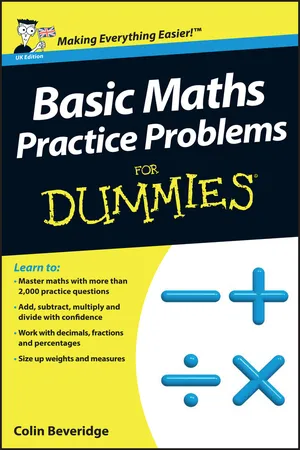Part I
The Building Blocks of Maths
In this part . . .
In this part, I take you through the real foundations of Basic Maths: the skills you’ll need to have so you can master the other, more involved chapters.
You’re going to need to know how to add, take away, multiply and divide – as well as how to estimate and round numbers.
Once you’ve got all of that under your belt, the rest is easy!
Chapter 1
Getting Started
In This Chapter
Handling whole numbers and fiddling with fractions
Managing measurements and speaking statistically
You can do this.
Before you start, sit up straight, breathe in and take a minute to reassure yourself that you’re smart and that you do maths all the time without realising it.
Every time you cycle to work, you perform feats of mathematics that would require supercomputers to work out in anything like the timescale your brain can do them in – from deciding which path to take to avoid the lorry, to figuring out exactly when to brake for the traffic lights, and even to remembering the combination for your bike lock.
Okay, maybe you don’t need a supercomputer for the last one, but the point stands: you’re much better at maths than you realise. Maybe you don’t yet have a handle on the kind of maths you need to do well in exams, but that’s just a matter of time.
In this chapter, I show you how to get better at that other kind of maths, the sort you need to get qualifications, and I take you quickly through the topics I cover in the rest of the book.
Covering the Basics
You may have a mental image of a mathematician – enormous forehead, crazy hair, thick glasses, tweed jacket over a tasteless shirt with pens neatly arranged in the breast pocket, gesticulating madly at a blackboard covered in crazy equations.
Actually, I do know mathematicians like that – but we’re not all so poorly adjusted. Being good at maths doesn’t automatically turn you into a socially awkward egghead.
That’s not the only good news, though: you’re also excused from having to understand all those crazy equations. Virtually no algebra is covered in the numeracy curriculum (just a few simple formulas). All you need to be able to do is:
Add, take away, divide and multiply confidently: If you can use all of these maths tools, you’ll probably find the chapters in Part I relatively easy to work through. If you can’t, Chapters 2 to 4 help you build a solid foundation to work from.
Figure out the right sum to do: Working out which tool to use to answer a question can be tricky, but if you keep a clear head and think through what the question is asking, it will make sense in the end. Promise.
Make sense of measures: ‘Measure’ doesn’t just mean being able to use a ruler, although that’s a good starting point. It’s also about weighing, taking temperatures, telling the time and working with shapes. For dealing with shapes, you just need to know a few simple formulas for area and volume.
Read and understand graphs and basic statistics: Once you ‘get’ graphs, the answers start to jump off the page. You only need to care about a mere handful of types of graph, and you just need to figure out where each of them is hiding the information. Until you know that, graphs can be a bit confusing – but don’t worry, I take you through them as gently as I can!
Talking Yourself Up
The stories you tell yourself are extraordinarily powerful. I used to tell myself I was useless and stupid, despite some evidence to the contrary. I was miserable, prone to panic attacks and generally conformed to what I’d told myself.
Eventually I made some changes to my life and told myself I was capable and intelligent instead. It was astonishing how quickly things got better – I still have the odd bad day, but at least I’m a functioning human being these days.
Unfortunately, the stories most people tell themselves about maths are just as poisonous as the stories I used to tell myself. So, before you get started, please do one thing for me: look at the stories you tell yourself. If you say things like ‘I don’t have a maths brain’ or ‘I’m rubbish at maths’, you’re digging a hole for yourself. Try telling yourself these stories instead:
‘I used to struggle with maths – but I’m putting that right now.’
‘I’m much better at maths than I thought!’
‘I’m working on my maths skills.’
You don’t need to tell yourself that you’re going to win the next series of Countdown (although practising with games is a great way of honing your mental arithmetic), just give yourself a good name to live up to!
Collecting th...



